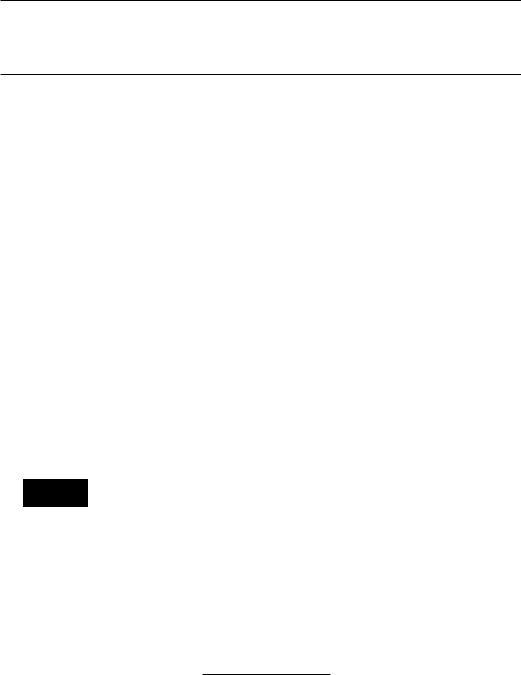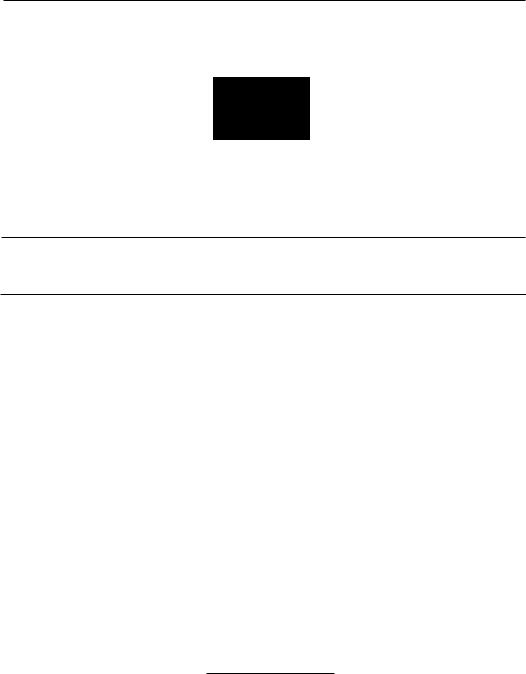
CFA Level 1 (2009) - 1
.pdf
Study Session 3
Cross-Reference to CFA Institute Assigned Reading #11 - Hypothesis Testing
Figure 1: Hypothesis Testing Procedure
State the hypothesis
~
Select the appropriate test statistic
~
Specity the level of significance
~
State the decision rwe regarding the hypothesis
~
Collect the sample and calculate the sample statistics
~
Make a decision regarding the hypothesis
~
Make a decision based on the results of rhe test
• (501lI'cc: Wayne \Xi. Daniel and James C. Terrell, Busillcss Stlltistics, B,/sic Concepts and Mctf,ot!o!ogr. Houghton Ivlifflin, Boston, 199-.J
OJ Pro!£'Hor:,- Note: JOlt should knoll' thio' process.'
The Null Hypothesis and Alternative Hypothesis
The null hypothesis, designated H o' is the hypothesis dlat [he researcher wants to reject. It is the hypothesis that is actually tested and is the basis for the selection of the test st:Histics. The null is generally stated as a simple statement about a population parameter. Typical statements of the null hypothesis for the population mean include
= 1-10' H o: ~ ::; 1-10' and H o: 1-1 2: 1-10' where \1- is the population mean and 1-10 is the hypothesized value of the population mean. The null hypothesis always includes the =
SIgn.
The alternative hypothesis, designated H" is what is concluded if there is sufficient evidence to reject the null hypothesis. It is usually the al[ernative hypothesis that you are really trying to assess. Why? Since you can never really prove anything with statistics, when the null hypothesis is discredited. the implication is that the alternative hypothesis is valid.
One-Tailed and Two-Tailed Tests of Hypotheses
The alternative hypothesis can be one-sided or two-sided. A one-sided test is referred to as a one-railed test. and a two-sided test is referred to as a two-tailed test. Whether the test is oneor two-sided depends on the proposition being tested. If a researcher wants ro test whether the return on srock options is greater than zero, a one-tailed test should be used. However, a two-tailed test should be used if [he research question is whether the return on options is simply different from zero. Two-sided tests allow for deviation on both sides of the hypothesized value (zero). In practice, most hypothesis tests are constructed as two-tailed tests.
A two-tailed test for the population mean may be structured as:
H o: IL = 1-10 versus H a: 1-1 7: 1-10-
©2008 Kaplan Schweser |
Page 291 |

Study Session 3
Cross.:Reference to CFA Institute Assigned Reading #11 - Hypothesis Testing
Since the alternative hypothesis allows for values above and below the hypothesized parameter, a two-tailed test uses two critical values (or rejection points).
The general decision rule for a two-tailed test is:
Reject H o if: |
test statistic> upper critical value or |
|
test statistic < lower critical value |
Let's look at the development of the decision rule for a two-tailed test using a z-distributed test statistic (a z-test) at a 5% level of significance, 0'.
• At 0'. = 0.05, the computed test statistic is compared with the critical z-values of
± 1.96. The values of ± 1.96 correspond to ±ze,/2 which is the range of z-values within which 95% of the probability lies. These values are obtained from the cumulative probability table for the standard normal distribution (z-table), which is included at the back of this book.
•If the computed test statistic falls outside the range of critical z-values (i.e., test statistic> 1.96. or test statistic < -1.(6), we reject the null and conclude that the sample statistic is sufhci.:l1th· different from the hypothesized value.
If the computed test sl;ltistic falls within the range ± 1.96, we conduc!c that the sample statistic is not surtlcicnrly Jiffercl1t from the hypothesized valu.: (p = flO in this case), and we fail to rejeer the null hypothesis.
The decisiol1 mit- (rejection rule) for iI two-tailed z-tCJt at (\ = 0.05 can be stated as:
Reject H o if test statistic < -1.96 or if test st;ltistic > 1.96.
Figure 2 shows the standard normal distribution for a two-tailed hyputhesis test using the z-distribution. Notice that the significance level of 0.05 means that there is 0.05 / :2
= 0.025 probability (area) under each tail of the distribution beyond ± 1.96.
Figure 2: Two-Tailed Hypothesis Test Using the Standard Normal (z) Distribution
2.5%
-1.96 |
|
1.96 |
||
|
|
|
|
|
|
|
|
|
|
Reject Hn |
|
Fail to Reject Ho |
|
Reject Hll |
|
|
|
|
|
o |
Professor's Note: The next two examples are extremely important. Don't move |
|
|
|
on until you understand them.' |
Page 292 |
©2008 Kaplan Schweser |

Study Session 3
Cross-Refer~nce to CFA Institute Assigned Reading #11 - Hypothesis Testing
Example: Two-tailed test
-, ,'-
A researcher has gathered data on: the dailyreturp.sona portfolio of call options '.
over a recent 250-day period. The mean daily return has bee~O.l%, andthe~ainple .' . standard deviation of daily portfolio returnsis·Q;~5%.The researcher believes that.
the mean daily portfolio return is not equal to zero. Constwct a hypothesis test ofthe researcher's belief. .
Answer:
First we .need to specify the null and alternativeh~potheses.The nullhypothesisis.the one' the researcher expects, to reject; " ',' .
Since the null hypothesis is an equality, this is a rwo-tailed test. At a 5% level of significance, the critical z-values for a two-tailed test are ± 1.96, so the decision rule can be stated as:
Reject H o if +1.96 < test statistic < -1.96.
0.001 |
0.001 = 6.33. |
|
OUf test statistic is (0.0022j~ |
||
0.000158 |
||
../250 |
|
Since 6.33 > 1.96, we reject the null hypothesis that the mean daily option return is equal to zero. Note that when we reject the null, we conclude that the sample value is significantly different from the hypothesized value. We are saying that the two values are different from one another after considering the variation in the sample. That is, the mean daily rerurn of 0.001 is statistica11ydifferent from zero given the sample~s standard deviation and size.
For a one-tailed hypothesis test of the population mean, the null and alternative hypotheses are either:
Upper tail: H o: p ::; P'o versus H a : p, > p,o' or
Lower rail: H o: p. 2':1-10 versus Ha : ~L < \.Lo
The appropriate set of hypotheses depends on whether we believe the population mean, p" to be greater than (upper tail) or less than (lower tail) the hypothesized value. \.Lo' Using a z-test at the 5% level of significance, the computed test statistic is compared with the critical values of 1.645 for the upper tail tests (i.e., H a: p, > \.Lo) or -1.645 for lower tail tests (i.e., H a: \.L < \.Lo)' These critical values are obtained from a z-table, where -zo.os = -1.645 corresponds to a cumulative probability equal to 5%, and the zoos = 1.645 corresponds to a cumulative probability of95% 0- 0.05).
©2008 Kaplan Schweser |
Page 293 |

Study Session 3
Cross-Reference to CFA Institute Assigned Reading # 11 - Hypothesis Testing
Let's use the upper tail test structure where H o: fl ~ flo and H a : fl > flo'
•If the calculated test statistic is greater than 1.645, we conclude that the sample statistic is sufficiently greater than the hypothesized value. In other words, we reject
the null hypothesis.
• If the calculated test statistic is less than 1.645, we conclude that the sample statistic is not sufficiently different from the hypothesized value, and we fail to reject the null hypothesis.
Figure 3 shows the standard normal distribution and the rejection region for a one-tailed test (upper tail) at the 5% level of significance.
Figure 3: One-Tailed Hypothesis Test Using the Standard Normal (z) Distribution
|
|
|
/' ~(l'(l |
-- /// |
'~ |
||
----=='----------------- |
|
I |
|
|
1.645 |
||
|
|
|
|
Fail to Reject H, |
|
|
Rcjecr ~C' |
Example: One-tailed test
Perform a z-test using the option portfolio data from the previous example to test the belief that option returns are positive.
Answer:
In this case, we use a one-tailed test with the following structure:
The appropriate decision rule for this one-tailed z-test at a significance level of 5% is:
Reject H o if test statistic> 1.645
The test statistic is computed the same way, regardless of whether we are using a onetailed or two-tailed test. From the previous example, we know that the test statistic for the option return sample is 6.33. Since 6.33 > 1.645, we reject the null hypothesis and conclude that mean returns are statistically greater than zero at a 5% level of significance.
Page 294 |
©2008 Kaplan Schweser |

Study Session .J
Cross-Reference to CFA Institute Assigned Reading #11 - Hypothesis Testing
The Choice of the Null and Alternative Hypotheses
The most common null hypothesis will be an "equal to" hypothesis. Combined with a "not equal to" alternative, this will require a two-tailed test. The alternative is often the hoped-for hypothesis. When the null is that a coefficient is equal to zero, we hope to reject it and show the significance of the relationship.
When the null is less than or equal to, the (mutually exclusive) alternative is framed as greater than, and a one-tail test is appropriate. If we are trying to demonstrate that a rerurn is greater than the risk-free rate, this would be the correct formulation. We will have set up the null and alternative hypothesis so that rejection of the null will lead to acceptance of the alternative, our goal in performing the test.
LOS l1.b: Define and interpret a test statistic, a Type I and a Type II error, and a significance level, and explain how significance levels are llsed in hypothesis testing.
Hy"porhesis testing involves two statistics: the test statistic calculated from the sample data and the critical value of the test statistic. The value of the computed test statistic relative to the critical value is a ke!' step in assessing the validity of a hypothesis.
i\ test statistic is calculated by comparing the point estimate of the population parameter with the hypothesized value of the parameter (i.e., rhe value specified in the null hypothesis). With reference to our option return example. this means we are concerned with the difference between the mean rerum of the sample (i.e .. x = 0.001) and the hypothesized mean return (i.e., flo = 0). As indicated in the following expression. the test statistic is the difference between the sample statistic and the hypothesized value. scaled by the standard error of the sample statistic.
.. |
sample statistic - |
hypothesized value |
|
test statistic = _~ |
---'.2 |
_ |
|
standard error of the sample statistic
The standard error of the sample statistic is the adjusted standard deviation of the sample. When the sample statistic is the sample mean, x, the standard error of the sample statistic for sam pie size n, is calculated as:
when the population standard deviation, CT, is known, or
when the population standard deviation. CT, is not /enown. In this case, it is estimated using the standard deviation of the sample, s.
©2008 Kaplan Schweser |
Page 295 |

Study Session 3
Cross-Reference to CFA Institute Assigned Reading # 11 - Hypothesis Testing
Professor's Note: Don't be confused by the notation here. A Lot ofthe Literature O YOlt wiLL encounter in your studies simpLy uses the term ax for the standard
error ofthe test statistic, regardLess of whether the popuLation standard deviation or sampLe standard deviation was used in its computation.
As you will soon see, a test statistic is a random variable that may fol low one of several distributions, depending on the characteristics of the sample and the population. We will look at four distributions for test statistics: the t-distribution, the z-distribution (standard normal distribution), the chi-square distribution, and the F-distribution. The critical value for the appropriate test statistic-the value against which the computed test statistic is compared-is a function of its distribution.
Type I and Type II Errors
Keep in mind thal ll\'pothesi~ r('sring i~ usnJ [() make int~T(,llces abour the paramerers or a given popularion ('11 the basis or srarisric; computed for a ~amplt- thal i~ drawn from rhat popularion. W'e must he aware rhat rhert is some probabiliry rhat the sample, in some way, does nor represenr rhe popularion, and any conclusion based on rhe sample abour rhe popularion may be made in error.
\'\'hen drawins infeL,:nces from a hyporhesi~ test, rhere arc rwo rypes of errors:
• Type I error: rhe rejecrion of the null hypothesis when ir is actually rrue.
•Type II error: the failure to reject rhe null hypothesis when ir is actually false.
TIH:' significance level is rhe probability of making a Type I error (rejecring rhe
null when ir is rrue) and is designared by rhe Greek letter alpha (a). For insrance, a significance level of 5% (a = 0.05) means there is a 5% chance of rejecring a true null hypothesis. \X/hen conducring hyporhesis resrs, a significance level must be specified in order to identify rhe crirical values needed to evaluate rhe resr sraristic.
LOS ll.c: Define and interpret a decision rule and the power of a test, and explain the relation between confidence intervals and hypothesis tests.
The decision for a hypothesis tesr is to eirher rejecr rhe null hyporhesis or fail to rejecr the null hypothesis. Note rhat it is sratisrically incorrecr to say "accepr" rhe null
hyporhesis: ir can only be supporred or rejecred. The decision rule for rejecring or failing to rejecr rhe null hypothesis is based on rhe distribution of the tesr sratistic. For example, if the resr sratistic follows a normal disrriburion, rhe decision rule is based on critical values determined from rhe standard normal distriburion (z-disrribution). Regardless
of the appropriate disrribution, ir musr be derermined if a one-railed or two-railed hypothesis test is appropriare before a decision rule (rejection rule) can be determined.
A decision rule is specific and quantirative. Once we have derermined wherher a oneor two-railed rest is appropriate, the significance level we reguire, and the disrribution of rhe resr srarisric, we can calculare the exact critical value for rhe resr statistic. Then we have a decision rule of the following form: if rhe resr statistic is (greater, less rhan) the value X, reject the null.
Page 296 |
©2008 Kaplan Schweser |

Study Session 3
Cross-Reference to CFA Institute Assigned Reading #11 - Hypothesis Testing
The Power of a Test
While the significance level of a test is the probability of rejecting the null hypothesis when it is true, the power of a test is the probability of correctly rejecting the null hypothesis when it is false. The power of a test is actually one minus the probability of making a Type 1I error, or 1 - P(Type 1I error). In other words, the probability of
rejecting the null when it is false (power of the test) equals one minus the probability of not rejecting the null when it is false (Type 1I error). When more than one test statistic may be used, the power of the test for the competing test statistics may be useful in deciding which test statistic to usc. Ordinarily, we wish to use the test statistic that provides the most powerful test among all possible tests.
Figure 4 shows the relationship between the level of significance, the power of a test, and the two types of errors.
Figure 4: Type I and Type II Errors in Hypothesis Testing
|
|
|
hilt' ('o/ltli/ioll |
||||
|
|
|
|
|
|
|
|
|
Dc:cisioll |
|
H o is false |
||||
|
|
|
|
|
|
|
|
|
|
|
Correct Decision |
[IlCO!Tect Decision |
|||
|
|
|
|
Type II Error |
|||
|
|
|
|
||||
|
|
|
|
|
|
|
|
|
|
|
Incorrect Decision |
Correer Decision |
|||
|
|
|
Type I Error |
Power or the test |
|||
|
|
|
Significance level. n. |
= I - P(Type II Error) |
|||
|
|
|
= P(Type 1 Error) |
|
|
|
|
|
|
|
|||||
Sample size and the choice of significance level |
(Type I error probability) will together |
||||||
determine the probability of a Type II error. The relation is not simple, however, and |
|||||||
calculating the probability of a Type II error in practice is quite difficult. Decreasing the significance level (probability of a Tvpe I error) from 5% to 1%, for example, will increase the probability of failing to reject a false null (Type II error) and therefore reduce the power of the test. Conversely, for a given sample size, we can increase the power of a test only with the cost that the probability of rejecting a true null (Type I error) increases. For a given significance level, we can decrease the probability of a Type II erwr and increase the power of a test, only by increasing the sample size.
The Relation Between Confidence Intervals and Hypothesis Tests
A confidence interval is a range of values within which the researcher believes the true population parameter may lie.
A confidence interval is determined as:
sa~pl.e_ (critical) (standard)] ::; population::; [sa~pl.e+ (critical) (standard)]} {[statistic value error parameter statistic value error
©2008 Kaplan Schweser |
Page 297 |

Srudy Session 3
Cross-Reference to CFA Institute Assigned Reading-#ll - Hypothesis Testing
The interpretation of a confidence interval is that for a level of confidence of, say, 95%, there is a 95% probability that the true population parameter is contained in the interval.
From the previous expression, we sec that a confidence interval and a hypothesis test are linked by the critical value. For cxample, a 95% confidence interval uses a critical value associated with a given distribution at the 5% level of significancc. Similarly,
a hypothesis test would compare a test statistic to a critical value at the 5% level of significance. To see this relationship more clearly, the expression for the confidence interval can be manipulatcd and restated as:
-critical value S tCSt statistic S +critical valuc
This is the range within which we fail to rejcct the null for a two-tailed hypothesis test at a given level of significance.
Example: Confidence inten'al
Using option portfolio data from the previous examples, construct a 95% confidence interval for the population mean daily return over the 250-day sample period. Use a z-distributiol1. Decide if the hypothesis ~l = 0 should be rejected.
Answer:
Given a sample size of 250 with a standard deviation of 0.25%, the standard enOf can be computed as Sx- = j.j;; = 0.25/.,/250 = 0.0158% .
At the 5% level of significance, the critical z-values for the confidence interval are zO.025 = 1.96 and -zO.025 = -1.96. Thus, given a sample mean equal to 0.1 %, the 95% confidence interval for the population mean is:
0.1-1.96(0.0158) S fl S 0.1 + 1.96(0.0158), or
0.069% :S f..l:S 0.1310%
Since there is a 95% probability that the true mean is within this confidence interval, we can reject the hypothesis f..l = 0 because 0 is not within the confidence interval.
Notice the similarity of this analysis with our test of whether f..l = O. We rejected the hypothesis f..l = 0 because the sample mean of 0.1 % is more than 1.96 standard errors from zero. Based on the 95% confidence interval, we reject f..l = 0 because zero is more than 1.96 standard errors from the sample mean of 0.1%.
The p-vaLue is the probability of obtaining a critical value that would lead to a rejection of the null hypothesis, assuming the null hypothesis is true. It is the smallest level of significance for which the null hypothesis can be rejected. For one-tailed tests, the
p-value is the probability that lies above the computed test statistic for upper tail tests or below the computed test statistic for lower tail tests. For two-tailed tests, the p-value
Page 298 |
©2008 Kaplan Schweser |

Srudy Session 3
Cross-Reference to CFA Institute Assigned Reading #11 - Hypothesis Testing
is the probability that lies above the positive value of the computed test statistic pLus the probability that lies below the negative value of the computed test statistic.
Consider a two-tailed hypothesis test about the mean value of a random variable at the 95% significance level where the test statistic is 2.3, greater than the upper critical value of 1.96. If we consult the Z-table, we find the probability of getting a value greater than
2.3 is (l - 0.9893) = 1.07%. Since it's a two-tailed test, our p-value is 2 x |
1.07 = 2.14%, |
as illustrated in Figure 5. At a 3%, 4%, or 5% significance level, we would |
reject the null |
hypothesis, but at a 2% or 1% significance level we would nor. Many researchers report p-values without selecting a significance level and allow the reader to judge how strong the evidence for rejection is.
Figure 5: Two-Tailed Hypothesis Test with p-value = 2.14%
--- 2.5% ;/\ 2.5~·o ----
Neoative |
Critical Value for 5% |
Test |
b |
statistic |
|
ofrhe |
significance level |
|
test |
|
|
statistic |
|
|
LOS 11.d: Distinguish between a statistical result and an economically meaningful result.
Statistical significance does not necessarily imply economic significance. For example, we may have tested a null hypothesis that a strategy of going long al I the stocks that satisfy some criteria and shorting all the stocks that do not satisfy the criteria resulted in returns that were less than or equal to zero over a 20-year period. Assume we have rejected the null in favor of the alternative hypothesis that the returns to the strategy are greater than zero (positive). This does not necessarily mean that investing in that strategy will result in economically meaningful positive returns. Several factors must be considered.
One important consideration is transactions costs. Once we consider the costs of buying and selling the securities, we may find that the mean positive returns to the strategy
are not enough to generate positive returns. Taxes are another factor that may make a seemingly attractive strategy a poor one in practice. A third reason that statistically
significant results may not be economically significant is risk. In the above strategy, we have additional risk from short sales (they may have to be closed our earlier than in the test strategy). Since the statistically significant results were for a period of 20 years, it may be the case that there is significant variation from year to year in the returns from the strategy, even though the mean strategy return is greater than zero. This variation in returns from period to period is an additional risk to the strategy that is not accounted for in our test of statistical significance.
©2008 Kaplan Schweser |
Page 299 |

Srudy Session 3
. Cross-Reference to CFA Institute Assigned Reading #11 - Hypothesis Testing
Any of these factors could make commirring funds to a strategy unarrractive, even though the statistical evidence of positive returns is highly significant. By the nature of statistical tests, a very large sample size can result in highly (statistically) significant results that are quite small in absolute terms.
LOS II.e: Identify the appropriate test statistic and interpret the results for a hypothesis test concerning 1) the population mean of a normally
distributed population with a) known or b) unknown variance, 2) the equality of the population means of two normally distributed populations, based on independent random samples with a) equal or b) unequal assumed variances, and 3) the mean difference of two normally distributed populations (paired comparisons test).
When hypothesis testing, the choice between using a critical value basco on the
t-distrihlltion or the z-distribution depends on sample size. the distribution or the popu!:llion, and whether or l10t the variancc of thc jlopuL!tion is known.
The t- Test
The is a widely used hypothesis [cst that cmploys a test statistic that is distributed accoroinf~ ro a t-oistrihution. Following arc the rules for when it is appropriate to usc the {-test for hypothesis tests of the population mean.
[Jir thr Hes{ ~(thrpop II latio II 1'Izrial1u' is unknowl1 and either of the follo\ving conditions eXist:
•The sample is large (n 2 30).
• The sample is small (less than 30), but the distribution of the population is normal or approximately normal.
If the sample is small and the distribution is non normal, we have no reliable statistical test.
The computed value for the test statistic based on the I-distribution is referred to as the t-statistic. For hypothesis tests of a population mean, a t-statistic with n - 1 degrees of freedom is computed as:
x - flo
tn~J = / I s '-in
where:
X sample mean
P'o hypothesized population mean (i.e., the null) s standard deviation of the sample
n sample size
Professor's Note: This computation is not new. It is the same test statistic computation that we have been performing all along. Note the use ofthe sample standard deviation, s, in the standard error term in the denominator.
Page 300 |
©2008 Kaplan Schweser |
